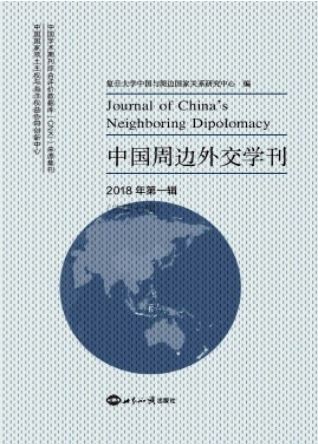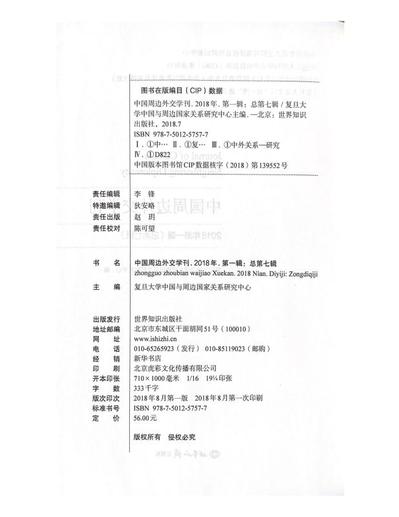The Title Page ofJournal of China’s Neighboring Diplomacy, Vol. 4, Issue 1, 2018 |
The Copyright Page of Journal of China’s Neighboring Diplomacy, Vol. 4, Issue 1, 2018 |
Center for China’s Relations with Neighboring Countries of Fudan University (CCRNC-Fudan), ed., Journal of China’s Neighboring Diplomacy, Vol. 4, Issue 1, 2018.
Publisher: World Affairs Press (China)
Published in August 2018.
ISBN: 978-7-5012-5757-7
Contents
Preface Zhao Minghao / 1
China’s Neighboring Countries Studies Report I
The Imperatives of Launching Studies on China’s Neighboring Countries Shi Yuanhua / 9
Subject Orientation, Analytical Perspective and Key Areas of China’s Neighboring Countries Studies Li Wen / 15
Theoretical Perspectives and Theoretical Significance of China’s Neighboring Countries Studies Zhou Fangyin / 21
What Characterizes China’s Neighboring Diplomacy? Zhao Minghao / 25
Opportunities and Challenges of Constructing China’s Neighboring Countries Studies Guan Peifeng / 29
Comparison, Transition and Integration of Views towards Neighboring Diplomacy between China and Japan Zhu Shuguang / 33
Comprehensive Studies on China’s Neighboring Diplomacy
Donald Trump, China and Asia Ren Xiao / 41
The Impact of China’s Foreign Policy Changes on the Settlement of the Border Issues Gao Fei and Zhou Yuping / 56
New Trends of U.S. and Japan’s Security Policy and Current Situations on “One Peninsula and Three Seas” Gao Lan / 73
“The Belt and Road” Research
“The Belt and Road” and the Reshaping of the Security Environment surrounding China Cao Yunhua / 91
Public Diplomacy for Religious Affairs and Soft Environment Construction for the Belt and Road Fan Lei and Yang Luhui / 109
Cultural Exchanges of China’s Neighboring Countries
Humanity Exchanges in the Construction of “Belt and Road”: Challenges and Responses Xing Liju / 135
China-Malaysia Cultural Exchange and Education Cooperation in the context of 21st Century Maritime Silk Road Li Yiping / 148
Economic Cooperation of China’s Neighboring Areas
A View on the China-ASEAN Economic Integration from the Perspective of Investment Zhang Miao and Danny Wong Tze Ken / 161
Regional cooperation between Northeast China and Far east area of Russia: Process, Challenge and Responsive Policy Xie Xiaoguang and Wang Li / 187
Domestic Conditions of China’s Neighboring Countries
Political Survival and Abe’s China Policy on Yasukuni Shrine Cheung Mong / 199
Related research of Japan on the Central Asia Uranium and Enlightenment to China Wang Dong / 213
Reviews on Symposiums
A Review on the Seventh Symposium of “China’s Neighboring Diplomacy in 2017” Xiao Yang / 235
A Review on the Second Symposium of “China’s Maritime Strategies” Gao Lan / 243
A Review on the Second Symposium of “Religion and China’s Neighboring Diplomacy under the ‘Belt and Road’ Initiative” Zou Lei and Tu Yichao / 249
A Review on the Second Symposium of “Relations between Transnational Ethnic Groups and China’s Neighboring Countries” Li Yuanyuan / 256
A Review on the International Symposium of “Current Security Situation in Central Asia and its Influence on China” Zhao Huasheng / 263
A Review on the Symposium of “Practical Cooperation between the ‘Belt and Road’ and China-ASEAN” Chen Miaoling / 271
A Review on the International Symposium of “Vibrant Development of East Asia and Contributions by China, Japan and South Korea” Xu Weijun / 279
Appendix
Introduction on the Collaborative Innovation Center for Territorial Sovereignty and Maritime Rights (CICTSMR) / 287
Introduction on Center for China’s Relations with Neighboring Countries (CCRNC) / 289
Notice Inviting Contributions to the Journal of China’s Neighboring Diplomacy / 291
Donald Trump, China and Asia
Ren Xiao
Abstract:The election of Donald Trump to U.S. presidency was a key development for both the United States and the whole world. The “Trump shock” has brought about various uncertainties and complicated all kinds of relations. The Trump administration released its National Security Strategy of the United States of America report within its first year of governing. The report reflects the U.S. establishment’s major strategic and foreign policy ideas and thus deserves much attention. China maintains its momentum of steady and continuous growth and takes an effort to keep a stable Sino-U.S. relationship. The further uplifting of China’s national power and its international status can be safely anticipated. Many Asian nations are redefining their own interests in accordance with the situational changes, particularly their interests in security and development. They try to avoid taking side with big powers. North Korea’s nuclear and missile programs have achieved a breakthrough and has incurred more intensive sanctions from the international community. North Korea remains a major flashpoint in the Asian security landscape.
Author: Ren Xiao, Professor and Director of the Research Center on China’s Diplomacy, Fudan University. Previously he was Director of the Asia-Pacific Studies Section and American Studies Section of the Shanghai Institutes for International Studies (SIIS).
Official citation:Ren Xiao,“Donald Trump, China and Asia”, Journal of China’s Neighboring Diplomacy, Vol. 4, Issue 1, 2018, pp. 41-55.
The Impact of China’s Foreign Policy Changes on the Settlement of the Border Issues
Gao Fei and Zhou Yuping
Abstract:Since the founding of the People’s Republic of China, its diplomacy has witnessed and experienced three major and crucial transformations, which were both a reflection of the progress of times and an incarnation of the uplifting of its national strength improvement, the optimizing of its perceptions of the world, and the more comprehensive interactions between China and the international system. These transformations have posed a significant influence on China’s settlement of border disputes and its relations with neighboring countries. Based on a division of three eras of China’s diplomacy and a focus on the transformation of China’s relations with the international system, this paper analyzes the evolution of the objectives and practical paths of China’s foreign policy, and elaborates on the effects of China’s foreign policy changes over China’s ways of handling its border issues.
Author: Gao Fei, Professor of China Foreign Affairs University; Zhou Yuping, Ph.D. Candidate of China Foreign Affairs University.
Official citation:Gao Fei, Zhou Yuping, “The Impact of China’s Foreign Policy Changes on the Settlement of the Border Issues”, Journal of China’s Neighboring Diplomacy, Vol. 4, Issue 1, 2018, pp. 56-72.
New Trends of U.S. and Japan’s Security Policy and Current Situations on “One Peninsula and Three Seas” Gao Lan
Abstract:Since 2017, the situations on the Korean Peninsula have become increasingly tense and strained. Relatively big changes already have already taken place in the East Asia. Aggravated by the “combined dual effect” brought by “uncertainties” of the Asia-Pacific policy of the Trump administration in U.S. and “riskiness” of the security and defense policy of the Abe administration in Japan, the security situations become more and more gloomy and confrontational in the Asia-Pacific region, particularly in the areas of “One Peninsula and Three Seas” (namely, the Korea Peninsula and the East China Sea, the South China Sea and the Sea around Taiwan). Propelled by some unexpected urgent events, some parts of these areas were very likely to approach the brinks of “hot war” on some occasions. Now there is a spillover in the security competitions between China on the one side and U.S. and Japan on the other side, which appears to be regionally or even globally influential. This may reflect the true nature of these changes.
Author: Gao Lan, Research Professor, Deputy Director of the Center for Japanese Studies and Director of the Center for Maritime Strategic Studies, Fudan University.
Official citation:Gao Lan,“New Trends of U.S. and Japan’s Security Policy and Current Situations on ‘One Peninsula and Three Seas’”, Journal of China’s Neighboring Diplomacy, Vol. 4, Issue 1, 2018, pp. 73-87.
“The Belt and Road” and the Reshaping of the Security Environment surrounding China
Cao Yunhua
Abstract: China’s success in its policy of reform and opening should be largely attributed to a favorable environment in its peripheral areas. In the past 30 years, China has established good relations with its neighboring countries that are characterized by mutual trust, mutual understanding, and mutual benefits. Such a favorable surrounding environment provides China with important links, effective strategic supports, and sustainable supply of resources that push forward China’s peaceful development and its closer connections with the world. However, there have been some reversions in China’s relations with its neighboring countries in recent years. In pace with the occurring of new situations and new problems in China’s neighboring areas, more distrusts and suspicions appear, and a variety of disputes and frictions become more frequent. Furthermore, big powers outside China’s neighboring areas are increasingly involved in these areas. The relations between China and its neighboring countries have already fallen into a trap of “coexistence of economic interdependence and security dilemma”. Therefore, the aim of this paper is to identify the various factors that affect the relations between China and its neighboring countries and look for breakthrough points that may help to improve these relations.
Author: Cao Yunhua, Professor of School of International Studies and Academy of Overseas Chinese Studies, Jinan University.
Official citation:Cao Yunhua,“‘The Belt and Road’ and the Reshaping of the Security Environment surrounding China”, Journal of China’s Neighboring Diplomacy, Vol. 4, Issue 1, 2018, pp. 91-108.
Public Diplomacy for Religious Affairs and Soft Environment Construction for the Belt and Road
Fan Lei and Yang Luhui
Abstract: In recent years, the emerging trends of global de-secularization and resurgence of religions have pulled religions back to the center of international relations from their marginalized positions within the Westphalia System in the past 300 years. Particularly, ever since the “9•11” event, almost all the major events of the world have been more or less influenced by religious factors. Religions have become a soft power that is increasingly influential in the development of international relations. In China’s diplomatic arrangements, the statuses of religions also become more and more outstanding. China’s practices of public diplomacy embodied in religious exchanges have been viewed as important means and ways to promote mutual understandings between common peoples, strengthen China’s discourse power, and improve China’s international image. The peaceful exchanges between different religions in history along the ancient silk road that connected China and many regions may offer many references to China at present time for its construction of the “Belt and Road”. At present, there are many different civilizations and religions in the areas of the “Belt and Road”. On the one hand, there are religious heterogeneities and tolerances in these areas, characterized by cooperative coexistence of different religions. On the other hand, there are also disagreements and even conflicts hidden in the interactions between these religions. Therefore, contemplations should be made on the issues of how to push forward China’s friendly exchanges with countries along the “Belt and Road” under the new situations in the region and the international community, how to strengthen plural coexistence and peaceful tolerance between different religions, and how to avoid the risks and challenges of religious extremism. Also, it is meaningful to accelerate the soft environment construction along the “Belt and Road”, so as to realize the common development and achieve a win-win pattern between China and “Belt and Road”-covered countries.
Authors:Fan Lei, Ph.D. of International Politics, Researcher of the Center for Studies on Social Stability and Crisis Management, Shandong Institute of Law and Politics, and Guest Researcher of the Research Institute of Contemporary Socialism, Shandong University. Yang Luhui, Professor and Ph.D. Tutor, Dean of the Asia-Pacific Research Institute of Shandong University, Researcher of the Research Institute of Contemporary Socialism, Shandong University.
Official citation:Fan Lei, Yang Luhui, “Public Diplomacy for Religious Affairs and Soft Environment Construction for the Belt and Road”, Journal of China’s Neighboring Diplomacy, Vol. 4, Issue 1, 2018, pp. 109-131.
Humanity Exchanges in the Construction of “Belt and Road”: Challenges and Responses
Xing Liju
Abstract:The “Belt and Road” initiative is a significant theoretic and practical innovation made by China’s leadership in the new time. As one of the three columns, humanity exchanges enjoy a significant status in the process of constructing “Belt and Road”, because these exchanges may lay down a solid foundation for deepening bilateral and multilateral cooperation. Humanity exchanges along the “Belt and Road” helps to push forward understandings between common peoples and deepen cooperation in economy and trade. Currently, there are a series of challenges and difficulties in the countries along the “Belt and Road”, such as cultural and religious conflicts, instable politics, interventions by forces from outside these areas, and China’s limited capacity to conduct external communications and contacts. For the purpose of carrying forward humanity exchanges smoothly in the “Belt and Road” areas, China should advocate more frequent exchanges and mutual appreciations between different cultures on the basis of equality, enrich the present dialogue mechanism for humanity exchanges, encourage non-official organizations to play an even more outstanding role through a pattern of cooperation between official and non-official organizations. Furthermore, China should strengthen its capacity to take international communications and take an effort to develop cultural industries. The humanity exchanges along the “Belt and Road” is a long process that needs patience for slow transformations. There should be no hastiness or impatience in this process.
Authors:Xing Liju, Professor of the Institute of International Studies and Researcher of the Center for China’s Relations with Neighboring Countries, Fudan University.
Official citation:Xing Liju,“Humanity Exchanges in the Construction of ‘Belt and Road’: Challenges and Responses”, Journal of China’s Neighboring Diplomacy, Vol. 4, Issue 1, 2018, pp. 135-147.
China-Malaysia Cultural Exchange and Education Cooperation in the context of 21st Century Maritime Silk Road
Li Yiping
Abstract: Since the beginning of the 21st century, in order to safeguard its own national interest and regional stability, Malaysia’s regional strategy is to maintain the balance among great powers and to strengthen the cooperation between great powers and the ASEAN members. Meanwhile, China believes that a stable neighborhood is an important condition for peaceful development. Therefore, in order to maintain and develop the overall interests of bilateral relations and peaceful development, The governments of China and Malaysia plan to strengthen their cultural exchanges in the context of 21st Century Maritime Silk Road, with an emphasis on mutual trust and communication as the important foundation for strengthening bilateral friendship. China and Malaysia are currently at the stage of economic and social transformation, which leave considerable room for both to promote mutually beneficial cooperation. While China and Malaysia used to focus on economic and trade relations, it is expected that in the future, the two countries will promote bilateral culture exchange and political cooperation, thereby shaping a shared future of cooperation at all levels including in politics, economics and culture.
Author:Li Yiping, Professor and Dean of Center for Southeast Asian Studies of Xiamen University.
Official citation:Li Yiping,“China-Malaysia Cultural Exchange and Education Cooperation in the context of 21st Century Maritime Silk Road”, Journal of China’s Neighboring Diplomacy, Vol. 4, Issue 1, 2018, pp. 148-158.
A View on the China-ASEAN Economic Integration from the Perspective of Investment
Zhang Miao and Danny Wong Tze Ken
Abstract: Propelled by domestic market, regional market, and trade agreements, the China-ASEAN economic integration is being strengthened continuously. Although Chinese transnational corporations have become involved in ASEAN region more actively than before due to the driving force brought by the regional trade agreements, it is still uncertain whether those small and medium enterprises in Southeast Asian countries are more involved into and obtain benefits from this process of regional economic integration. This paper conducts a research on the interactions between Chinese transnational corporations stationed in ASEAN countries and domestic small and medium enterprises. Based on a case study of the Chery Automobile Company, this paper finds out that, notwithstanding the influence brought by China’s state strategy of “going abroad” and the favorable regional trade agreements, Chinese transnational corporations are also heavily influenced by the state policy of host countries in Southeast Asia. Chery Company’s experience in Malaysia indicates that the spillover effect brought by Chinese transnational corporations in Southeast Asia is rather limited, and so are their connections to domestic business. This is because most enterprises entering this region highly rely on the trade network of their local partner enterprises for expanding their own business. This paper argues that Chery Company needs to adjust its regional strategy and takes an effort to push itself onto a more important position in the international value chains. In this way, it may push forward the development of its own business and further uplift its international competitiveness.
Author: Zhang Miao, Ph.D. Candidate of the Institute of Chinese Studies, Malaysia University; Danny Wong Tze Ken, Professor and Dean of the Institute of Chinese Studies, Malaysia University.
Official citation:Zhang Miao and Danny Wong Tze Ken, “A View on the China-ASEAN Economic Integration from the Perspective of Investment”, Journal of China’s Neighboring Diplomacy, Vol. 4, Issue 1, 2018, pp. 161-186.
Regional cooperation between Northeast China and Far east area of Russia: Process, Challenge and Responsive Policy
Xie Xiaoguang and Wang Li
Abstract:China's strategy to revitalize the old industrial bases in Northeast China has become synchronized with Russia’s ambitious plan of developing its Far East region. This synchronization gives both countries a great opportunity to enhance their bilateral cooperation. Some achievements have already been made in the cooperation between Northeast China and Russia’s Far East region, but there are also some challenges, such as: difficulties of implementing policies and plans, disturbances to immigration, uncertainties in energy cooperation, and perceptions of these two countries towards each other. To address these challenges, a better cooperation mechanism should be built soon, both countries should invest more money and deploy suitable policies to promote business-to-business cooperation, enhance Arctic collaborations, establish more connections of sister cities and strengthen people and culture exchange. Northeast China and Far east of Russia located in the center of Northeast Asia, the win-win cooperation between these two areas hold a great importance for each side, it will make great significance for the comprehensive strategic partnership of two countries and will contribute tremendously to the stability and proprietary of Northeast area.
Authors: Xie Xiaoguang, Research Center for the Economics and Politics of Transitional Countries, Liaoning University, Shenyang 110136, Liaoning, China.
Official citation:Xie Xiaoguang and Wang Li, “Regional cooperation between Northeast China and Far east area of Russia: Process, Challenge and Responsive Policy”, Journal of China’s Neighboring Diplomacy, Vol. 4, Issue 1, 2018, pp. 187-196.
Political Survival and Abe’s China Policy on Yasukuni Shrine
Mong CHEUNG
Abstract: The “Yasukuni problem” occupies a prominent position in the relations between People’s Republic of China (PRC) and Japan. In December 2012, Abe was re-elected as Japan’s prime minister after a landslide victory in the general election. One year after returning to office, Abe made a surprise visit to the Yasukuni Shrine on December 26, 2013. The visit was highly controversial outside of Japan, inviting furious protests not only from China and South Korea but also the United States. In the following two years, however, Abe decided not to visit the Yasukuni Shrine. Why did Abe visit the Yasukuni Shrine in 2013 but cease to visit it in 2014 and 2015? What is the vital factor that caused this policy variation? This article examines Japan’s different responses toward China’s pressure over the Yasukuni issue during the second Abe administration. With the examination of cases during the second Abe administrations since 2012, this paper offers an alternative interpretation by highlighting the rationality of prime minister and the primacy of domestic political survival of individual leader. The article suggests domestic political legitimacy of individual leaders is a vital factor that affects Japan’s China policy on Yasukuni.
Author: Mong CHEUNG, currently an associate professor in the School of International Liberal Studies (SILS), Waseda University, Japan.
Official citation:Mong CHEUNG, “Political Survival and Abe’s China Policy on Yasukuni Shrine”, Journal of China’s Neighboring Diplomacy, Vol. 4, Issue 1, 2018, pp. 199-212.
Related research of Japan on the Central Asia Uranium and Enlightenment to China
Wang Dong
Abstract: Kazakhstan and Uzbekistan in Central Asia are two of the most important countries exporting Uranium mineral. As a nation heavily relying on the nuclear power, Japan has been pursuing a policy of diversifying energy import sources, so as to guarantee the supply of Uranium. Japan has been analyzing the Uranium resources of Central Asia from different perspectives ever since 1990s. They have made very fruitful achievements in these researches. And what is more important is the “system for guarantee of overseas mineral resources supply”, which not only offers an institutionalized insurance to its researches on the uranium resources in Central Asia, but also plays a significant role in support of a long-term stable supply of mineral resources for Japan. China should learn from Japan’s practices and experience as to launch a top design of a steady overseas import channels on the basis of intelligence collection of Central Asia Uranium and the integration of different agencies functions. Therefore, we can guarantee the study and maintenance with the Uranium from overseas by system constructions.
Author:Wang Dong, Ph.D. Candidate of the China Institutes of Contemporary International Relations.
Official citation:Wang Dong,“Related research of Japan on the Central Asia Uranium and Enlightenment to China”, Journal of China’s Neighboring Diplomacy, Vol. 4, Issue 1, 2018, pp. 213-231.
Link to the Chinese Version: http://www.iis.fudan.edu.cn/5e/66/c11003a155238/page.htm








